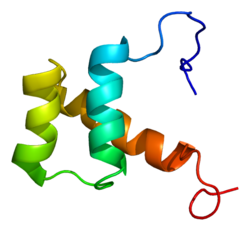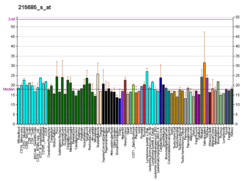DLX2
Homeobox protein DLX-2 is a protein that in humans is encoded by the DLX2 gene.[5][6]
Many vertebrate homeo box-containing genes have been identified on the basis of their sequence similarity with Drosophila developmental genes. Members of the Dlx gene family contain a homeobox that is related to that of Distal-less (Dll), a gene expressed in the head and limbs of the developing fruit fly. The Distal-less (Dlx) family of genes comprises at least 6 different members, DLX1-DLX6. The DLX proteins are postulated to play a role in forebrain and craniofacial development. This gene is located in a tail-to-tail configuration with another member of the gene family on the long arm of chromosome 2.[6]
Interactions
[edit]DLX2 has been shown to interact with DLX5,[7] MSX1[7] and Msh homeobox 2.[7]
References
[edit]- ^ a b c GRCh38: Ensembl release 89: ENSG00000115844 – Ensembl, May 2017
- ^ a b c GRCm38: Ensembl release 89: ENSMUSG00000023391 – Ensembl, May 2017
- ^ "Human PubMed Reference:". National Center for Biotechnology Information, U.S. National Library of Medicine.
- ^ "Mouse PubMed Reference:". National Center for Biotechnology Information, U.S. National Library of Medicine.
- ^ Ozcelik T, Porteus MH, Rubenstein JL, Francke U (Sep 1992). "DLX2 (TES1), a homeobox gene of the Distal-less family, assigned to conserved regions on human and mouse chromosomes 2". Genomics. 13 (4): 1157–61. doi:10.1016/0888-7543(92)90031-M. PMID 1354641.
- ^ a b "Entrez Gene: DLX2 distal-less homeobox 2".
- ^ a b c Zhang, H; Hu G; Wang H; Sciavolino P; Iler N; Shen M M; Abate-Shen C (May 1997). "Heterodimerization of Msx and Dlx homeoproteins results in functional antagonism". Mol. Cell. Biol. 17 (5). UNITED STATES: 2920–32. doi:10.1128/mcb.17.5.2920. ISSN 0270-7306. PMC 232144. PMID 9111364.
Further reading
[edit]- Harris SE, Guo D, Harris MA, et al. (2003). "Transcriptional regulation of BMP-2 activated genes in osteoblasts using gene expression microarray analysis: role of Dlx2 and Dlx5 transcription factors". Front. Biosci. 8 (6): s1249–65. doi:10.2741/1170. PMID 12957859.
- Qiu M, Bulfone A, Martinez S, et al. (1995). "Null mutation of Dlx-2 results in abnormal morphogenesis of proximal first and second branchial arch derivatives and abnormal differentiation in the forebrain". Genes Dev. 9 (20): 2523–38. doi:10.1101/gad.9.20.2523. PMID 7590232.
- Selski DJ, Thomas NE, Coleman PD, Rogers KE (1993). "The human brain homeogene, DLX-2: cDNA sequence and alignment with the murine homologue". Gene. 132 (2): 301–3. doi:10.1016/0378-1119(93)90212-L. PMID 7901126.
- Simeone A, Acampora D, Pannese M, et al. (1994). "Cloning and characterization of two members of the vertebrate Dlx gene family". Proc. Natl. Acad. Sci. U.S.A. 91 (6): 2250–4. Bibcode:1994PNAS...91.2250S. doi:10.1073/pnas.91.6.2250. PMC 43348. PMID 7907794.
- McGuinness T, Porteus MH, Smiga S, et al. (1996). "Sequence, organization, and transcription of the Dlx-1 and Dlx-2 locus". Genomics. 35 (3): 473–85. doi:10.1006/geno.1996.0387. PMID 8812481.
- Zhang H, Hu G, Wang H, et al. (1997). "Heterodimerization of Msx and Dlx homeoproteins results in functional antagonism". Mol. Cell. Biol. 17 (5): 2920–32. doi:10.1128/mcb.17.5.2920. PMC 232144. PMID 9111364.
- Yu G, Zerucha T, Ekker M, Rubenstein JL (2002). "Evidence that GRIP, a PDZ-domain protein which is expressed in the embryonic forebrain, co-activates transcription with DLX homeodomain proteins". Brain Res. Dev. Brain Res. 130 (2): 217–30. doi:10.1016/S0165-3806(01)00239-5. PMID 11675124.
- Strausberg RL, Feingold EA, Grouse LH, et al. (2003). "Generation and initial analysis of more than 15,000 full-length human and mouse cDNA sequences". Proc. Natl. Acad. Sci. U.S.A. 99 (26): 16899–903. Bibcode:2002PNAS...9916899M. doi:10.1073/pnas.242603899. PMC 139241. PMID 12477932.
- Gerhard DS, Wagner L, Feingold EA, et al. (2004). "The status, quality, and expansion of the NIH full-length cDNA project: the Mammalian Gene Collection (MGC)". Genome Res. 14 (10B): 2121–7. doi:10.1101/gr.2596504. PMC 528928. PMID 15489334.
- Espinoza HM, Ganga M, Vadlamudi U, et al. (2005). "Protein kinase C phosphorylation modulates N- and C-terminal regulatory activities of the PITX2 homeodomain protein". Biochemistry. 44 (10): 3942–54. doi:10.1021/bi048362x. PMID 15751970.








